Like many other museums around the world, the Science Museum Group has an extensive collection of coins, many associated with the commemoration of figures, discoveries and key achievements in the history of medicine, science and industry. Most of these coins were and are still acquired specifically for those connections.
However, some other coins are not directly related to these themes, as they came from private collections formed primarily between the 19th and 20th centuries. Since the 15th century, coin-collecting was established as a common pastime for the European nobility, leading, over the next few centuries, to the creation of broad collections of coins from all over the world. These private assemblages, which included pieces from various times and places, have since found their ways into museum collections.
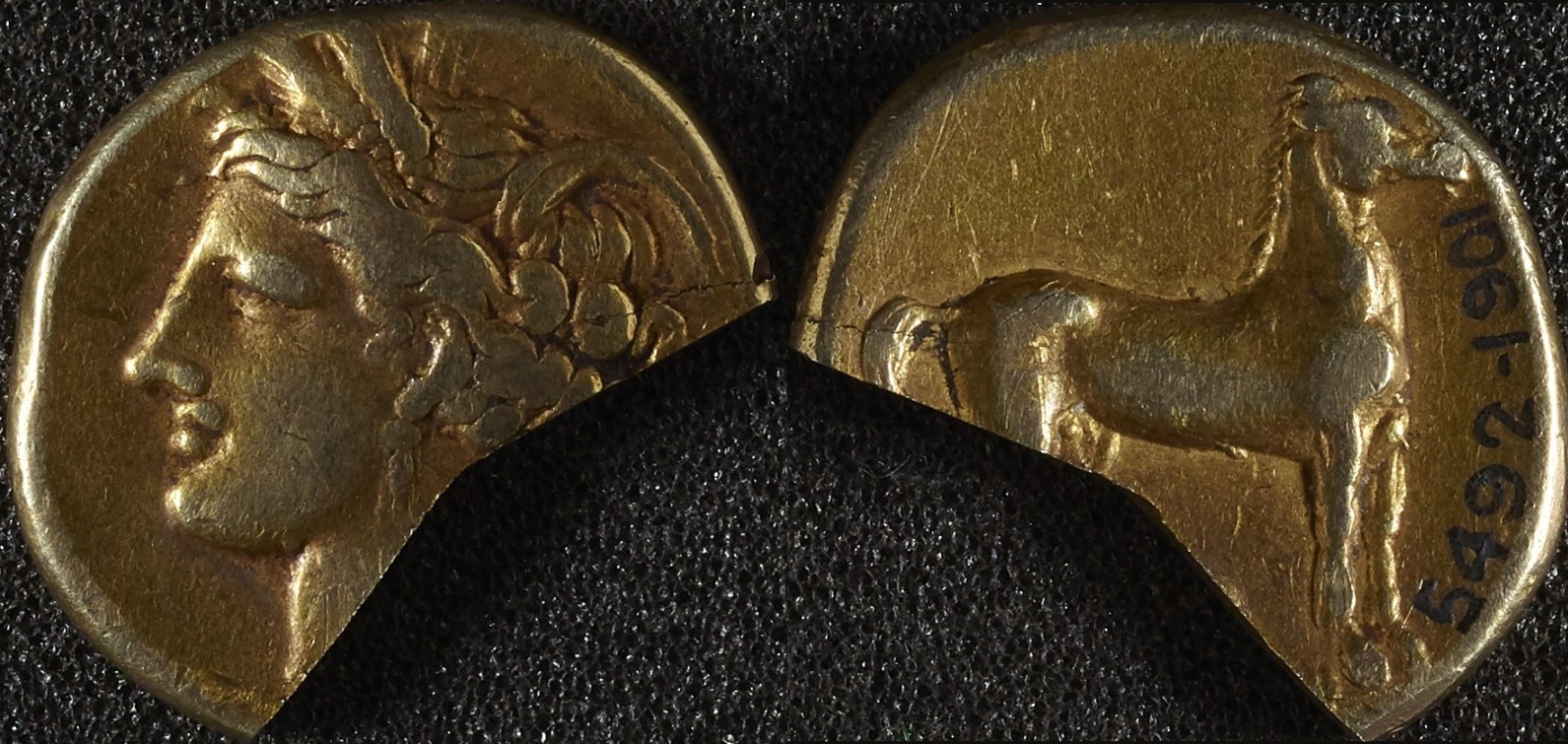
This is how many ancient coins became part of the Science Museum Group Collection. Ancient coins are an invaluable source of historical and archaeological information. Although, like today’s currencies, they reveal little about the individuals who used them, ancient coins can tell us a lot more about the bigger picture, such as political shifts, economic developments and historical trends.
The earliest known coins in the world are dated to the 7th century BCE and were found under the Temple of Artemis at Ephesus, in modern Turkey. In a time without newspapers or the internet, coins were often used as a powerful tool for propaganda. Due to their portable nature and their potential to circulate widely and reach a varied audience, coins were a medium to convey important messages. Rulers and countries used them to promote ideologies, showcase their power and wealth, and establish a sense of unity and identity among their subjects.
A coin consists of two sides: the obverse (head) is the front, while the reverse (tail) is the back. Sometimes, a legend running around the edges can give us more details and help with its identification.
An ancient coin’s shape or depiction was not relevant to establish its value; that was solely based on its content of metal and weight. As a result, it was not unusual for a coin-maker to shave off bits of a coin to make it the proper weight, resulting in an irregularly shaped product. Other times, an irregular shape could be due to illegal alterations to remove small amounts of precious metal, achieved through clipping coins around the edges.
Ancient coins and political power
In archaeology, Greek and Roman coins are a primary source of information about the beliefs and habits of the people of the time. Obverse and reverse portray important elements to the issuing city, including myths, animal, natural resources, historical events, buildings, temples, gods and heroes as well as figures of power.
A recurring theme sees the head of the ruler or of a mythological figure on the obverse and a representation of the virtues of the ruler or issuing city or country on the reverse. It was a way to spread political messages and the aspects of leadership that rulers wished to promote.
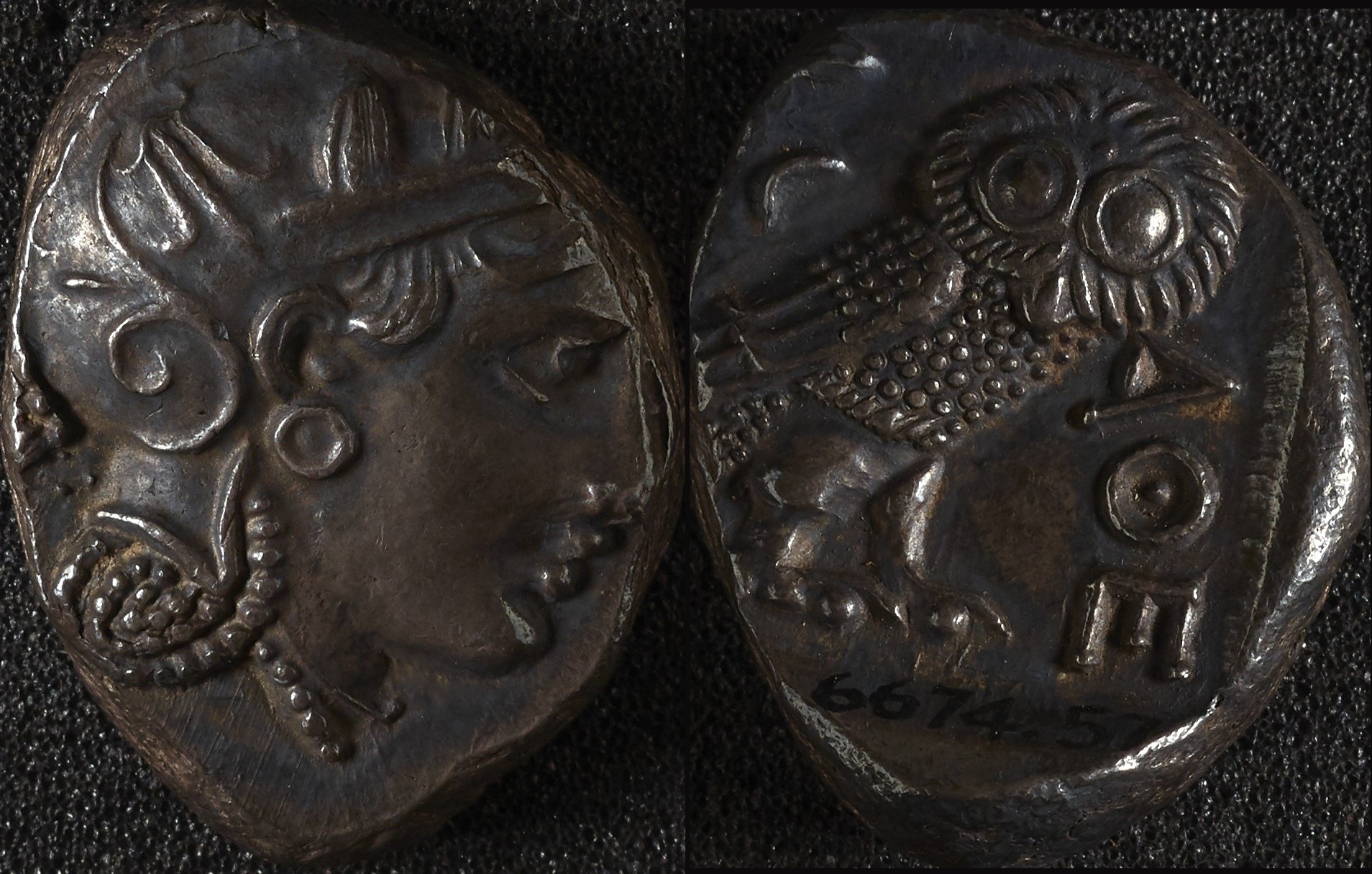
The silver coin above, minted in Athens during the 5th century BCE, features several symbolic elements tied to the city’s identity. The obverse depicts the head of Athena, patron goddess of Athens, wearing an Attic helmet decorated with olive leaves. The reverse represents the animal most closely associated with the goddess, an owl, standing with its head turned to the front. The inscription “ATHE” on the bottom right is an abbreviation for Athenaion, “of the Athenians”.
The Athenian “Owls”, as they were called, are among the most famous coins of the ancient world. They were minted in Athens from the end of the 6th century BCE for over four hundred years. While the style evolved during the centuries, the basic motives of the head of Athena on the obverse and the owl on the reverse survived.
The evolution of a coin’s style over time can reveal political and cultural shifts, although essential motifs often endured. An example can be seen in the coins of Alexander the Great (4th century BCE), king of the ancient Greek kingdom of Macedon.
One of the most widespread coin types of Alexander was the Heracles (or Hercules) design, which shows the greatest mythological hero of antiquity on the obverse. This type had been used before by several Macedonian rulers, including his father, but Alexander elevated the theme to an entirely new level.
He not only claimed to descend from Heracles, thus associating himself with a demigod, but Alexander also suggested that he was following in Heracles’ footsteps. In fact, it was thought that Heracles had carried out the conquest of the East, making him an excellent patron of Alexander’s campaigns in Asia.
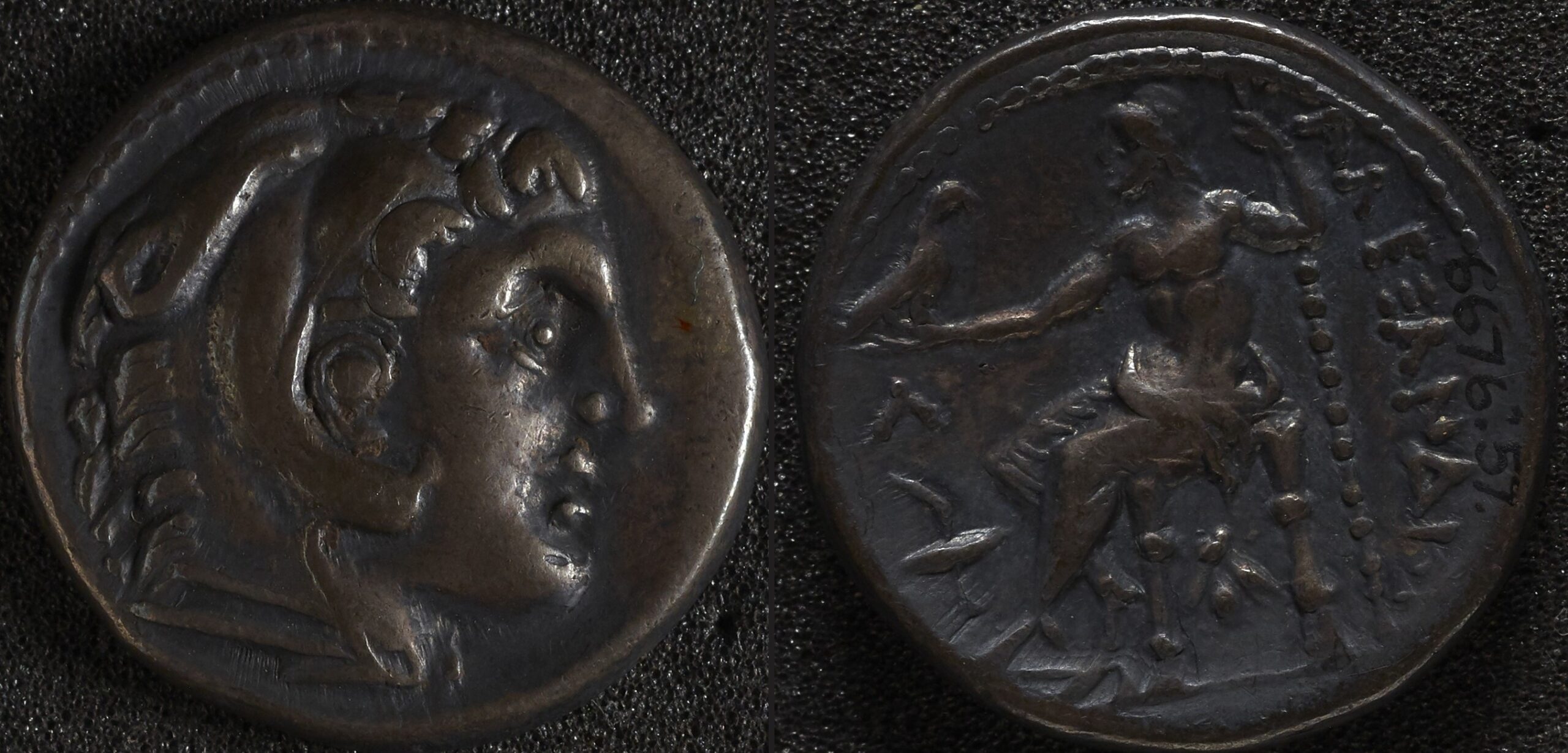
This coin above shows exactly this type. The obverse features a portrait of Heracles wearing his trademark lion skin headdress, with the open mouth of the dead lion positioned over the back of Heracles’ skull. The lion skin refers to Heracles’ killing the Nemean lion in the first of his Twelve Labours. The reverse pictures Zeus seated on his throne holding an eagle, his symbol, and a sceptre, which refers to his status as king of the gods. The legend on these coins reads, in Greek, “Of Alexander” (Alexandri).
Ancient Coins and Medicine
Many Greek and Roman coins in the Science Museum Group Collection are associated with medical subjects. The figures of Asclepius, god of Medicine, and several of his family members are commonly represented in these coins.
Asclepius usually appears in the traditional form of a middle-aged or elderly individual, although a few examples of him as young man exist. His coins can feature a staff and a serpent, separated or in the shape of the rod of Asclepius, with the serpent coiled around the staff.
The coin below is a common type from the city of Pergamon, in modern Turkey, home to a famous temple of the healing god. It shows the laureate head of Asclepius facing right on the obverse, while the reverse features the snake-entwined staff. Staff and snake are surrounded by a legend in Greek – now partially lost around the edges – reading “Asclepius our saviour” (Asklepios Soteros).
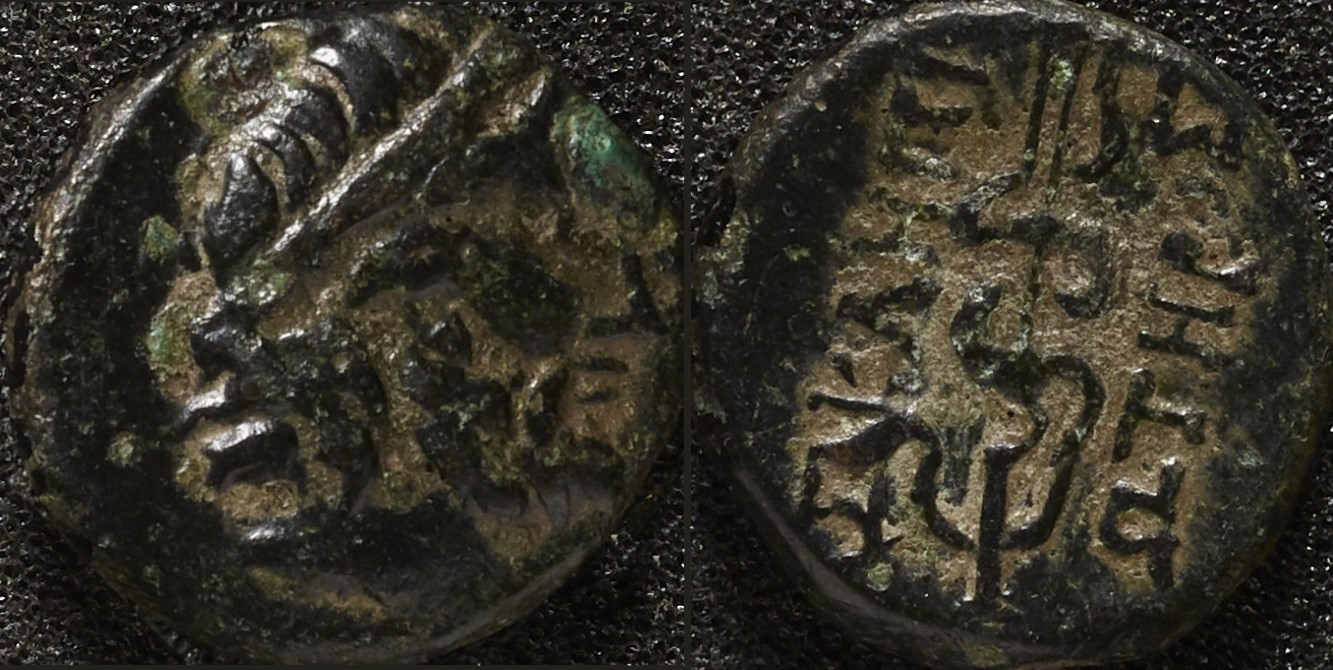
The cult of Asclepius was particularly common under the Roman Empire. On the coins from this period, Asclepius can be matched with or replaced by his son Telesphorus or his daughter Salus.
Salus is the Roman version of the Greek goddess Hygieia, personification of health, cleanliness and sanitation. She is frequently shown on coins holding a patera (bowl) and feeding a snake rising from an altar. An example can be seen on the reverse of the coin below, dating to the Roman emperor Hadrian’s reign (2nd century CE). The Salus type was extremely common throughout the imperial Roman period.

Striking coins featuring the gods and goddess of healing were also common during times of pandemic and mass outbreaks of disease. An example from Selinunte, Sicily, was issued in the 5th century BCE to celebrate the control of a malaria epidemic. It is said that the philosopher Empedocles managed to free the city from malaria by draining a stagnant area of water, which was a breeding ground for the mosquitoes carrying the disease.
. The event was commemorated on a coin showing the personification of the local river god sacrificing at the altar of Asclepius, represented by a serpent coiled around the altar. A plaster copy of this coin can be seen in the image below.

The depiction of women in the Roman world
The element of political propaganda found in the early ancient coins became standard motif during the Roman empire. As part of the imperial propaganda, the women of the royal family started to appear on coins as well. In absence of a succession law to the throne, the presence of a moral woman who would produce descendants was a way to strengthen the concept of dynasty and set an example of the virtues a Roman woman should embody.
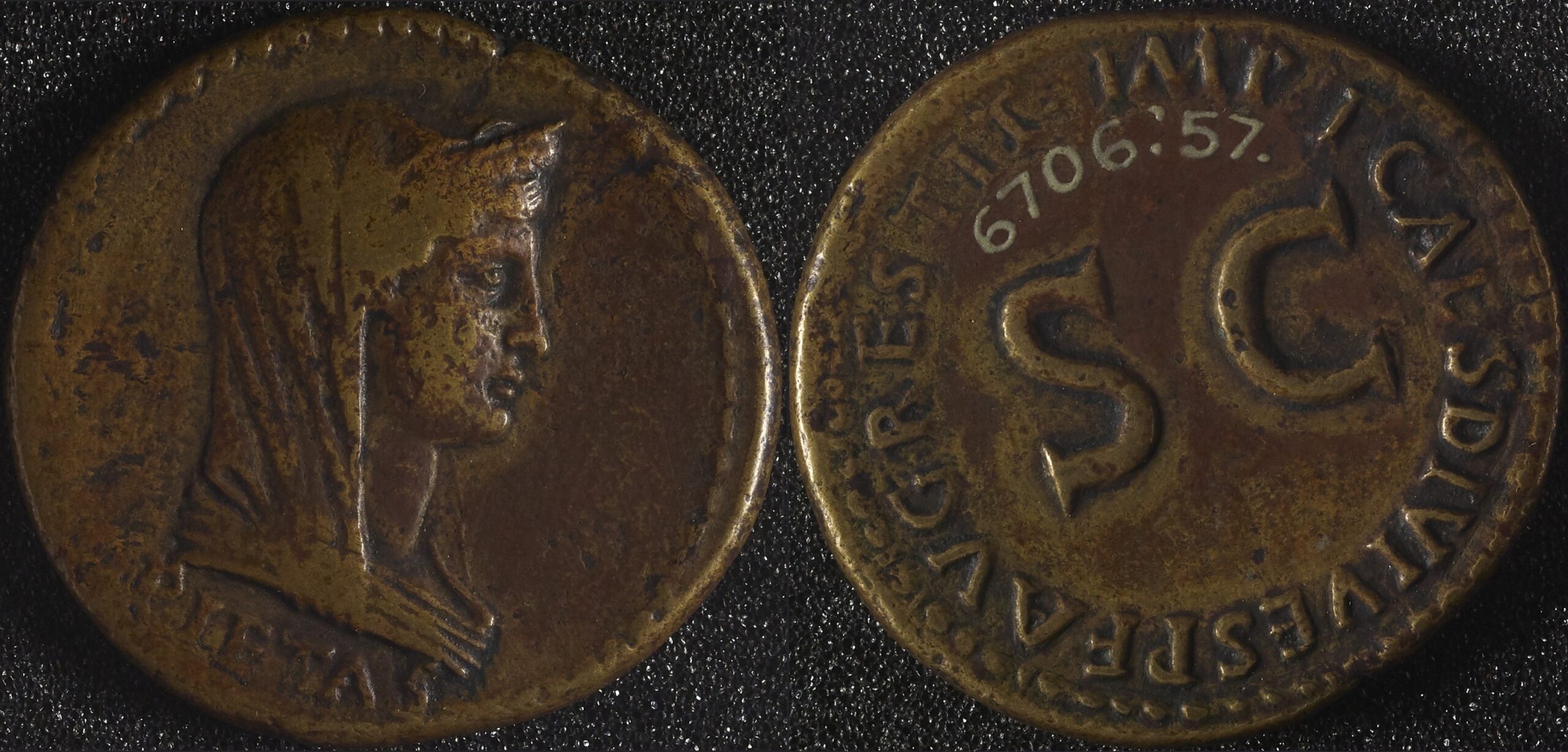
This example above was issued under the emperor Titus (79-81 CE). It is part of a series of coins referred to as “restoration coinage”, which copied types of coins minted by previous rulers. The coin depicts a veiled female character as the deity Pietas, goddess of piety, affection and dutifulness.
The traits of the woman in this portrait are highly idealised, but she is traditionally identified as Livia Drusilla (59 BCE – 29 CE), wife of the emperor Augustus and mother of the emperor Tiberius. Other interpretations have been suggested as well, but, regardless of who this figure is, she was an influent member of the imperial family represented in the role of a deity, and her representation on a coin reflects a way of building the imperial cult.
Another influential woman can be seen in the coin below. Faustina the Elder, sometimes referred to as Faustina I or Faustina Major, was the wife of emperor Antoninus Pius (138-161 CE). As an empress, Faustina was well respected and renowned for her beauty and wisdom. After she died in 141 CE, Antoninus Pius ordered the issue of a series of coin types to commemorate his late wife, including this example. The obverse displays the portrait of Faustina, facing right, showing her famous hairstyle. The reverse depicts a seated statue within a temple, representing Faustina’s temple, that still exists today in the Roman Forum.
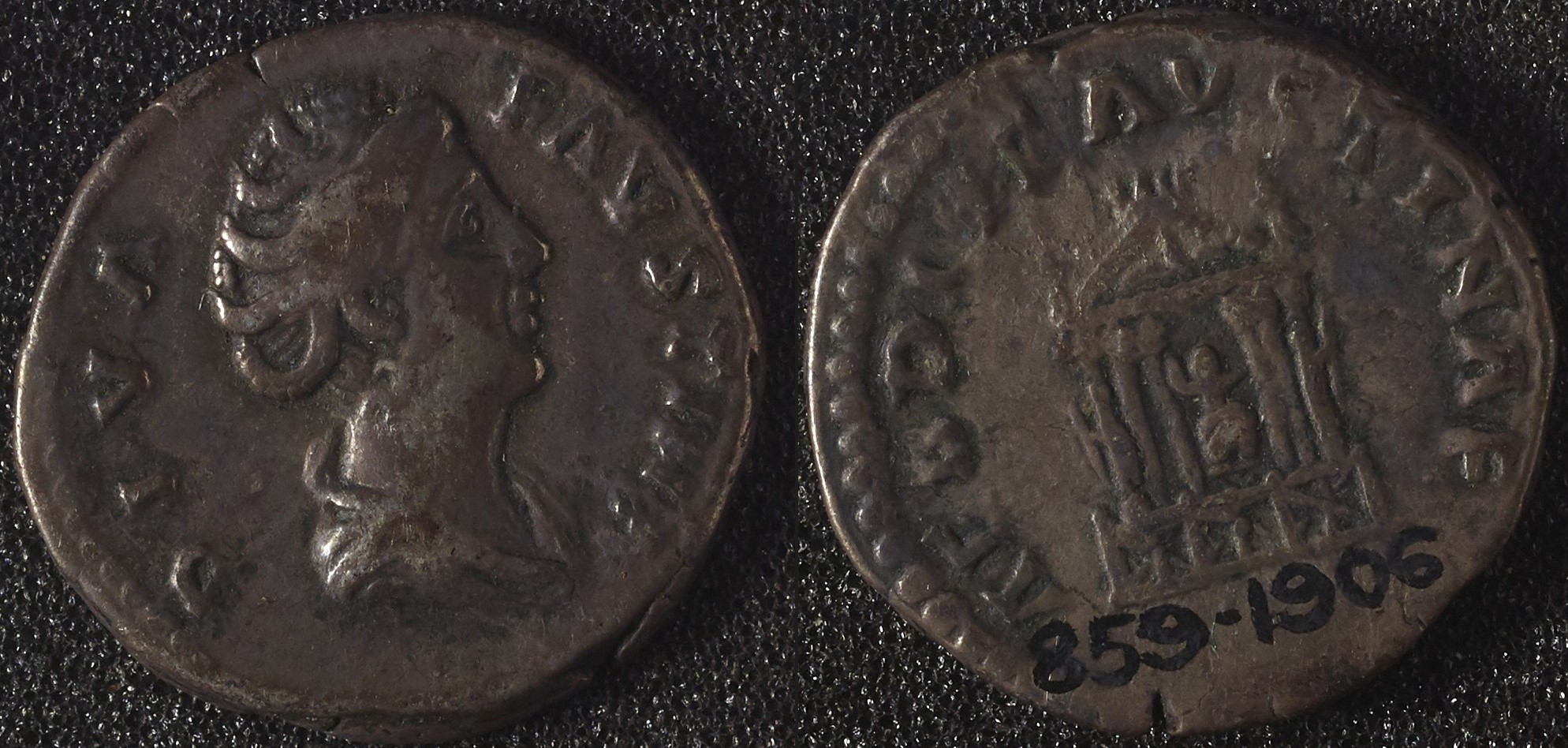
Historic coins collections and new finds
While most museums’ historic coins collections are made up of pieces acquired from private collections during the 19th and 20th centuries, new additions usually come from coins found in the ground by archaeologists, metal detectorists and members of the public. Coins are, in fact, the most common archaeological find in the UK.
Coins and precious items were often hidden in the ground for safe keeping during invasions and uncertain political times. The threats of foreign raids to the Roman empire in the 3rd century CE and the ‘English’ Civil War (1642-1648) are the most famous examples. Such hoards can help us date a site or understand the socio-economic conditions that led to their burial.
Often overlooked in museums, coins hold cultural, political and economic meanings and provide great insights into the past. They can be fascinating for aesthetic reasons and their age, but most importantly they are an invaluable resource to gain insights into the people and historic periods that created, used and, sometimes, buried them.
